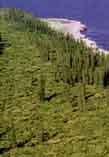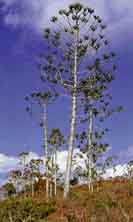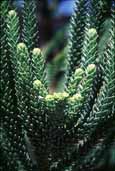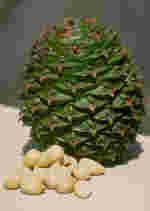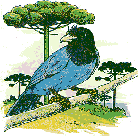|
|
Distribution of Araucaria, with numbers of species (3).
Araucaria columnaris (5).
Araucaria rulei (5).
Araucaria montana [C.J. Earle].
Araucaria bidwillii (6).
Araucaria angustifolia seeds are planted by the blue gralha (Corvidae) (7).
Common Names
Araucaria.Taxonomic notes
In this treatment there are 19 species. The genus may be divided into 3 sections as follows (2):Sect. Colymbea Endl.: A. araucana, angustifolia, bidwillii
Sect. Intermedia White: A. klinkii
Sect. Eutacta Endl.: A balansea, beccari, biramulata, bernieri, columnaris, cunninghamii, heterophylla, humboldtensis, muelleri, rulei
Note that this scheme does not assign some species. I am seeking more information on the taxonomy of this genus.
Description
Evergreen, mostly dioecious trees with regularly whorled branches. Buds inconspicuous. Young trees branched to the ground, old trees with a long clear bole and flattened crown. Juvenile leaves needle-like, thin, loosely imbricate, spirally arranged. Adult leaves usually scale-like or sometimes needle-like, spirally arranged or nearly 2-ranked, usually closely imbricate, overlapping, flattened, sometimes lanceolate and sharp-pointed, persistent for many years, often with faint stomata above. Male cones terminal and solitary or disposed in clusters, with numerous spirally arranged stamens, anthers 6-8 celled. Female cones globose, ripening in 2-3 years, heavy, milky; scales usually with thin spiny apical umbos, scales thin and somewhat flattened, cones dehiscent at maturity; ovules one per scale. Ovules and seeds united with the scale. Seeds usually winged on the edges, sometimes edible. Cotyledons 2-4. Germination with epigeal or hypogeal cotyledons (1).Range
South America and Australasia (1).Big Tree
Perhaps Araucaria araucana , although A. bidwillii also grows very large, and scanty data are available for most species. The tallest is almost certainly A. hunsteinii (89 m).Oldest
I have heard that A. araucana may exceed 1000 years. Data are lacking for most species.Dendrochronology
Limited work with A. araucana .Ethnobotany
Many species, due to their large size, are or have been important sources of timber. Examples include A. angustifolia, A. araucana, A. bidwillii, A. cunninghamii and A. hunsteinii . The nutritious and large seeds of A. bidwillii were an important food source for aboriginal peoples and are now an Australian delicacy.Observations
Some of the more impressive (large) species are popular ornamentals, widely planted in warm temperate and subtropical regions. Quite a few species may be seen in many warm temperate or tropical botanical gardens. Species native to temperate and subtropical regions in Chile, Argentina, Brazil, and Australia have been preserved in some public parks or forest preserves, where they may be found in their natural habitat. However, many of the tropical species, such as the 13 species endemic to New Caledonia or the Malesian species, have received limited protection, are difficult to locate in the wild, and are threatened with extinction. There is a trend toward recognizing the botanical significance of these tropical species and providing them with statutory protection, but at the same time their habitat is rapidly disappearing due to population and development pressures. Their fate is for the most part uncertain.Remarks
"[N]amed after the province of Arauco in South Chile" (2).Abstract of (4): "Pollination was studied in three species of Araucaria: A. cunninghamii, A. heterophylla and A. bidwillii . More limited observations were made for A. hunsteinii and A. angustifolia . The investigation revealed considerable variation among species of Araucaria with respect to pollination features. The bract scale of the receptive cone of both A. cunninghamii and A. heterophylla has a stoma-free furrow which directs pollen grains onto a thin flange on the tip of the ovuliferous scale. The bract scale of A. bidwillii bears stomata over most of its surface, and is broady scalloped so that pollen grains are deposited in a band across both bract and ovuliferous scales. On germination, the pollen tubes of these three species penetrate the epidermis of the scale and for a short distance grow beneath the surface before emerging and travelling, without branching or major deviation, towards the proximal end of the ovuliferous scale. Results are discussed in relation to pollination mechanisms in other conifers and to taxonomic divisions within the Araucariaceae."
Citations
(1) Silba 1986 .(2) Vidakovic 1991 .
(3) de Laubenfels 1988 .
(4) Haines, R.J.; Prakash, N. and Nikles, D.G. 1984. Pollination in Araucaria Juss. Australian Journal of Botany 32(6): 583-594.
(5) Schmid 1981 .
(6) Hortus Botanicus Catinensis, URL = http://www.dipbot.unict.it/orto/0001-1.html .
(7) Pinheiro-do-Paraná. Website at http://www.pr.gov.br/celepar/seet/prtur/diversos/pinheiro/index.html , accessed 12-Apr-1999.
[ Araucaria ] [ Araucariaceae ] [ home ]
This page is from the Gymnosperm Database
URL: http://www.geocities.com/~earlecj/ar/ar/index.htm
Edited by Christopher J. Earle
E-mail:
earlecj@earthlink.com
Last modified on 20-Apr-1999

